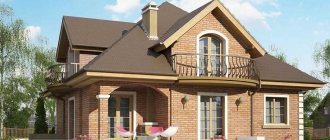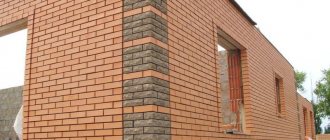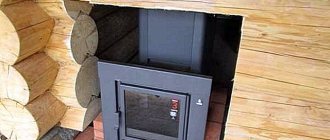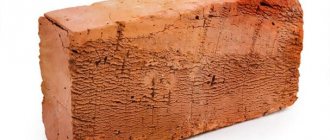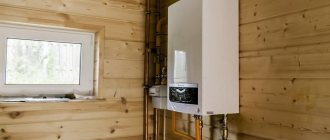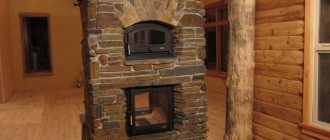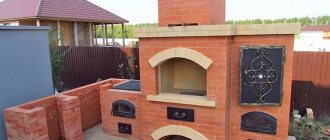Of course, one of the most important elements in arranging a bathhouse is the stove.
Metal stove lined with brick (in the steam room)
Before you begin to study the instructions for proper brick laying, you should answer the main question: why is it necessary to line the stove in a bathhouse with bricks? Perhaps your particular stove model does not require this action?!
Before and after
Compared to metal, brick retains heat much longer, which means the stove will cool down much longer.
The stove in the bathhouse plays no less important role than in the house. The effectiveness of all bath procedures and a comfortable atmosphere depend on how quickly it heats up and retains heat. Being in a cold room is unpleasant, and being in an excessively overheated room is dangerous to your health.
Metal stove in a steam room with 1/2 brick
Why cover with brick material?
Any work must be done thoughtfully, and before execution it is necessary to understand the reasons. The designs are easy to install, heat up quickly and are accessible to everyone due to their low price, but they have a lot of disadvantages.
In addition to the high heating rate, the surface is a source of infrared radiation, which is unpleasant for humans and burns the skin at a considerable distance.
Steel heaters dry out the air, which prevents the creation of the correct conditions in the bathhouse necessary for a comfortable procedure. When heating quickly, such a stove instantly gives off heat and has to be heated regularly, which increases the consumption of firewood and creates a lot of inconvenience.
Brickwork acts as a protective screen, allowing you to retain heat for a long time and rid you of infrared rays. Covering a sauna stove with bricks is inexpensive.
FAQ
Is it possible to use ceramic bricks to decorate a bathhouse?
It is possible, but not for the equipment of heating structures, since it does not withstand the load in the form of such high temperatures, since their limit is 200 C. But for laying the floor it will do, you just need to choose high-quality solid brick so that all copies are the same size , and the edges are smooth and flat.
In which bath would internal brick lining be appropriate?
In fact, any time. It all depends on your taste and imagination. Of course, the best option is a wooden bathhouse and a brick interior, since this choice is cheaper, more practical, and more durable than a completely brick or stone monolithic structure.
How to properly care for such a bath?
Brick has the unpleasant property of becoming covered with dirt, dust, and mortar residues, which can be difficult to remove when hardened. You should not use percussion instruments for this, as they will damage the structure. Therefore, it is better to stock up on sandpaper or use modern chemical cleaning methods: using phosphoric, sulfuric and hydrochloric acid. It is especially convenient to clean off the remnants of a solution that is of a clay nature.
What are the disadvantages of brick finishing?
There are no significant ones, there are only small disadvantages: ● long heating time. Brick takes a very long time to heat up, it will require more time and consumables, but it gives off heat much longer; ● moisture accumulation. Absorbs moisture from the air and takes a long time to dry; ● complexity of installation. Laying out a brick row correctly is not an easy task if you do it yourself and without the help of professionals.
Is it necessary to provide constant heating to such a bathhouse?
There is no direct need, since it is very expensive and will increase costs significantly. But this approach will definitely increase the service life of all premises. Plus, if you need to flood it urgently, for example, when guests arrive, then this will not be possible due to the prolonged heating of the brick.
Calculations for choosing a base
For the correct distribution of parameters, knowledge of the basic parameters is necessary:
- dimensions of the furnace and its weight;
- weight of stones in the heater;
- the mass of the container for heating the liquid and the volume of water (further calculations are based on the condition that a liter weighs 1 kilogram);
- the weight of the brick wall (depends on the type of stone, but standard fire brick = 4 kg).
When all the information is received, the specialist can easily carry out the necessary calculations. He will need to add up the weight of the stove, stones, brickwork, container and liquid. 20% is added to this amount to create an additional safety margin. It should be remembered that pressure is applied constantly, and if the boards do not meet the required characteristics, then sooner or later they will be pressed through.
If the resulting number does not exceed 600 kilograms, you can line a metal stove in a bathhouse with bricks without manipulating the foundation. For detailed calculations, you can use the information below.
Design nuances
The design of baths is regulated by the document SNiP II-L.13-62, which has recently been amended. According to the document, the steam room should be located in a separate building, its height should not exceed 2 floors. If, nevertheless, there is a bathhouse on 2 floors on the site, then according to the rules, rooms with a wet regime should be located above rooms with a wet regime.
To draw up a bathhouse project, you need to take into account several factors:
- placement of the building on the site;
- Consumables;
- layout of rooms and their number;
- the presence of window openings and doors;
- type of heating devices;
- communications supply;
- climatic conditions.
You can draw up a project yourself or contact a design bureau. The latter option is considered preferable, since the bureau has contacts of organizations where the project can be confirmed and construction can begin legally.
Calculation of dangerous load on floors (kg/m2)
To assess how much load your floor can support, the technician needs to know what kind of joists are used. In the table below you can see the capabilities of different types of joists to support weight in kilograms per square meter.
| Section (cm) | Beam length between supports | ||||||
| 2 m | 2.5 m | 3m | 3.5 m | 4 m | 5 m | 6 m | |
| 10×5 | 734 | 585 | 490 | 420 | 367 | 325 | 293 |
| 15×5 | 1650 | 1321 | 1101 | 942 | 827 | 733 | 665 |
| 20×5 | 2930 | 2347 | 1955 | 1675 | 1464 | 1303 | 1172 |
| 20×10 | 4867 | 4690 | 3910 | 3353 | 2933 | 2733 | 2607 |
| 20×20 | 11730 | 3987 | 7821 | 6705 | 5866 | 6215 | 4691 |
| Cylindrical shape 20 | 6912 | 5528 | 4608 | 3950 | 3456 | 3070 | 2765 |
| Cylinder. f. 22 | 9200 | 7360 | 6132 | 5256 | 4600 | 4090 | 3682 |
Using plaster
Plastering is the most budget-friendly option for finishing a stove yourself. The product takes on a finished look and looks good in the interior. After plastering, you can whitewash it with a special heat-resistant compound.
This type of finishing is quite often used for brick ovens. The technology is as follows:
- It is necessary to properly prepare the surface. All traces of old finishing, incl. plaster and tiles must be removed. Each seam should be selected at 10-15 mm.
- We dilute the deep penetration primer according to the instructions. Carefully prime the surface. Do not forget that the primer must dry (at least 24 hours).
- We stretch and fix the metal mesh using dowels. Such reinforcement will significantly increase the strength of the tile fastening.
- Apply plaster to the stove. We recommend using a ready-made mixture specifically for ovens. The plaster must be allowed to dry for 48 hours.
- Now the stove needs to be whitewashed.
Construction on foundation
If a metal sauna stove lined with brick is not suitable for installation according to the table, then in this case it is necessary to make a foundation. This task is simplified if you have just started building a building with your own hands and you do not need to dismantle the stove and floors.
To build a foundation, a hole about half a meter deep is dug around the perimeter of the masonry and filled 3/5 with crushed stone or a mixture of gravel and sand. It must be taken into account that contact with the bathhouse foundation is unacceptable.
After laying the cushion, a cement screed and a layer of waterproofing are made, after which formwork is made, which is filled with concrete mortar. For such a product to harden properly, it must be regularly moistened with water to avoid cracks.
The next stage is the construction of brick pillars that serve as support. It is recommended to do the masonry using clay mortar. All work must be carried out taking into account the level, avoiding distortions.
When everything is ready, the metal product is installed and covered with brick.
Insulation inside and outside
In modern houses, the wall is a multilayer structure made of various materials. The main rule of combining them is: the vapor permeability of the layers increases from the inside to the outside. Insulation from the inside is considered the worst option, since it is very difficult to fulfill this requirement.
Insulation scheme
The second major drawback of this solution: if you insulate the wall from the inside, then the dew point - the conditions for the formation of condensation - will be inside the room, and not outside. The third drawback is that thermal insulation takes up at least 15 cm of internal space.
You have to take this step in cases where you need to insulate a finished, tiled house. Moreover, if the cladding is made with siding, it is recommended to donate it and insulate the building from the outside.
If we are talking about a project, or about a house that is at the stage of building a foundation, then the issue of thermal insulation must be resolved in favor of another method.
Floor base
If the weight of your structure does not exceed the established standards, you can place the stand directly on the surface. If the bathhouse is many years old, the technician will still have to open the floor and inspect the joists and boards for damage. You also need to remember that the brick base also has its own weight and will put pressure on the floorboards.
If the wood is not suitable for the job or is not in perfect condition, it is not necessary to replace it. It is possible to reinforce them with a metal channel or additional wooden beam. It is worth considering the distance between the beams. If they are located more than a meter apart, the specialist will need to install additional ones so that the clearance between them is about 600 mm.
To lay the base, floorboards are placed ten centimeters larger than the size of the structure with the lining. On the firebox side, it is necessary to increase this distance to avoid burning elements from hitting the wood. Then a sheet of refractory material is placed on the marked area, on which brickwork is made about 200 mm high.
It is recommended to use refractory bricks without hollow sections for these purposes. You need to use a clay mortar, to which you can add a little cement mixture. All actions must be performed using a level. After preparing the base, you can think about how to properly brick a stove in a bathhouse.
Types of bricks used
A bathhouse is a room with a high degree of humidity, and this must be taken into account when choosing a material.
Moreover, for the interior decoration of different elements of the room you can and even need to use different types of bricks:
Solid - they are used for laying walls, but you should not lay out the stove with it.
Hollow - in finishing a bath it is a little useful, because it is suitable for making partitions, but not walls.
Fireclay - this choice is excellent for a stove, as it has high fire resistance.
Ceramic (red) - has average strength and fire resistance, optimal for all elements.
Clinker - rarely used due to its low prevalence, but is also suitable for a bathhouse, and universally.
Expert opinion
Lovkachev Boris Petrovich
Bath master who knows everything about steaming
Note: the quality of a brick can be determined by its color. For example, a bright red shade was burned in a kiln for a short amount of time, and a brown one was burned out. Both cases are of poor quality and are not suitable for construction.
Hand-molded brick, which has been gaining popularity in recent years, deserves special attention. It is usually used to restore ancient architectural monuments, but it is well suited for cladding and decorating sauna stoves, as well as chimneys.
Its aesthetic advantage is a large selection of colors, since clay, purified from impurities, is used for production.
For a bathhouse, hand-molded bricks are good because:
- does not allow moisture to pass through well, the inside of the bathhouse remains dry regardless of the weather outside;
- resistant to frost;
- does not deform;
- retains heat well inside and has high sound insulation;
- safe from an environmental point of view;
The disadvantage is the difficulty of manufacturing. The process consists of several stages, each of which requires a scrupulous and responsible approach. First you need to prepare the mixture. Next, the brick is molded manually or using a prepared mold. Drying, firing and the final stage - quality control.
For interior decoration, this is a good choice, but it is very time-consuming and requires considerable imagination from the manufacturer. With its help you can give your bathhouse a truly chic, incomparable look. There is an imitation of the fact that the building is many years old and has its own unique history.
Here is how the famous “Styling Master” Vladimir Kovalenko speaks about this:
“A good bathhouse is the pride of any owner. There is no consensus on which brick should be used. For each individual building you need to decide individually, depending on its size and your financial capabilities.”
Construction process
If you plan to cover it with bricks on all sides, then it will be a full covering, if only some sides are partial. When completely surrounded, it is possible to control the movement of warm air masses. To do this, doors are made at the top and bottom of the screen to stop the movement of air when closed.
The model, completely covered with masonry, creates an ideal microclimate typical for a Russian bath. If at least one open wall remains, it will be more like a sauna, and the stone will protect you from burns and accumulate heat.
Some useful tips
To ensure that the brick lining is correct and lasts for many years, you should use the following recommendations:
- the masonry is carried out in the usual way with dressing in half a brick;
- the structure cannot be connected to the bath walls;
- withstand a seam thickness of 5 mm;
- leave a gap of 3-5 cm between the metal walls of the stove and the screen;
- in the lower rows it is imperative to make openings through which cold air can freely enter. Accordingly, in the upper ones there are the same holes for the release of hot heat. Both below and above there should be no more than 2-3 openings, otherwise the wall, as a heat shield, will not fulfill its direct function;
- after laying each row, it is necessary to check it with a level: verticality and horizontality must be maintained everywhere;
- Carefully remove any remaining solution from both the inside and outside.
Screen construction options
To determine the answer to how to line a metal sauna stove correctly and with what kind of brick, it is necessary to consider all existing classifications.
By distance:
- solid - interferes with circulation, which reduces the heating rate;
- randomly - the brick is placed with holes, this type reduces the quality of shielding;
- a screen with doors at the top and bottom is an ideal option with the ability to adjust convection.
By arrangement of bricks:
- in size - increases the heating time of stones and consumes a lot of raw materials during construction;
- half a brick - the most suitable option with a durable wall and rapid warm-up;
- in a quarter of a stone - has good heating characteristics, but the strength of the masonry is reduced.
It is worth noting that an overly unstable option can be corrected using reinforcement with a special network, but still, a thin-walled lining should not be erected without good preparation.
Insulation
Insulation of a bathhouse is carried out in several stages:
- Exterior walls. The insulation is laid inside lightweight masonry.
For it, you can use sheets of expanded polystyrene, which are cut to the desired shape and filled with them into the space inside the lightweight masonry as the internal walls are built.
Mineral wool is also good for these purposes. External structures must be insulated so that when warming up the bathhouse there is no need to spend money on heating the entire building. The task of a sauna stove is to warm up the air inside the room. Internal walls. Here it is necessary to make a high-quality finish so that the heat does not escape into the walls. To do this, the rough masonry is waterproofed with coating materials (for example, bitumen mastic). Next, a layer of plaster is applied, a lathing is attached to it, and fiberglass is placed inside the resulting cells.
A layer of thermal insulation is laid (expanded polystyrene, ecowool, basalt wool). Next, the wall is covered with a vapor barrier (for example, foil), on top of which the finishing is placed. Experts recommend using lining, which quickly warms up and will become an obstacle to the transfer of heat to the brick.
The wall near the stove is insulated with a denser layer of heat-insulating material, according to the same principle as the internal surfaces of the bathhouse. Foil must be used as a vapor barrier, since the steam room is the wettest part of the bath and is subject to the most dramatic temperature changes.
The steam room must have high-quality ventilation so that when heated the room does not turn into a kind of thermos without air access.
What kind of brick to cover a stove in a bathhouse
Before the main procedure, you must first prepare all the materials. On the modern market you will find a huge variety of bricks, varying in size, aesthetic qualities and properties.
The choice of brick must be made based on the distance from the metal to the screen being built. If it is less than 250 mm, then this will lead to strong heating of the masonry and therefore it is better to use fireclay.
The optimal is 500 mm. For such buildings, an ordinary fire-resistant red stone is perfect. If you plan to install vents from below, then this material can be used closer.
Construction of a frame wall for installing a furnace with a remote firebox
A wise proverb says: “A bathhouse is built around a stove.” Adhering to this rule, arrange a foundation and a protective screen, and then begin to build a frame partition between the steam room and the dressing room.
For the partition, use timber soaked in antiseptic. The length of the beam is according to the height of the room, section 100 x 600 mm. Install two beams vertically, attach them to the floor and ceiling with perforated corners and self-tapping screws. Between the two beams you need to install a horizontal jumper and fix it with the same corners.
The result will be a frame in the shape of the letter H. At the bottom between the beams there will be brickwork and an exposed fuel channel; insulation and sheathing will be located on top.
Frame example
Use basalt wool 100 mm thick.
Thermal insulation basalt wool Paroc (Steam) thickness 100 mm
Install the slabs between the beams. Nail the horizontal battens of the sheathing 20 mm thick to install the lining. Using a construction stapler, secure the foil vapor barrier on both sides of the frame wall. Use clamps or nails to secure the lining, thus sheathing the upper part of the wall on both sides (vertical installation is assumed).
Fastening insulation and lining
There should be a distance of 3-4 cm between the brickwork and the fuel channel. Do not place the brick directly on the steel channel. The same distance must be maintained between the brick and the timber.
Masonry tools
For masonry we will use a solution of sand, fireclay clay and cement:
- soak 2 parts sand and 5 parts clay in water for one day;
- After 24 hours, add 1 part of cement and mix.
Before laying, soak the brick in water. Carry the masonry level and bandaged.
Types of brickwork
Correct dressing
If necessary, cut the brick with a grinder. It is most convenient to do the overlap using steel corners (it is on their shelves that the brick will rest).
Covering the opening
To ensure beautiful seams (and the masonry will be visible on both sides), use a factory plastic jig or steel square rod.
Drawing of a device for bricklaying
Don't forget to unstitch the seams after laying.
Furnace installation diagram. Brick portal. Recommended distances
The wall is being laid. The stove was installed immediately, for ease of work
The photo shows a brick portal and the firebox door of an installed stove. Gaps between brick and wood are visible, not yet filled with insulation.
The photo shows how the brick is laid between the wall of the log house and the stand (a vertical beam that also serves as a door frame)
Brick portal
When the masonry is completed, install pieces of basalt cardboard or mineralite into the specially left gaps. Do not use glass wool or polystyrene foam for these purposes under any circumstances.
The photo shows insulation around the brickwork
The last step will be the installation of platbands that will hide the insulation between the timber and the brick. The platbands just need to be sawed down at 45 degrees and nailed to the timber from the dressing room side with finishing nails.
Example of original finishing
Installation of the stove, its leveling and alignment are carried out after all construction and finishing work has been completed. But if not only the portal is being laid, but at the same time a brick screen is being erected around the stove, then the unit is immediately installed in its place and covered with film (so as not to get dirty with the mortar during operation).
Installation of a furnace with a remote firebox
Installing a sauna stove in its original location
Brick portal and oven - photo. Some craftsmen recommend building brick walls first, and only then covering the walls with clapboard
Characteristics of building materials
You can calculate the main indicators that a brick has for lining a metal or iron stove in a bathhouse using the following table:
| Options | Facing | Textured | Raised | Ceramic |
| Strength | M-250 | M-250 | M-250 | M-200 |
| Size, cm | 25×12×6,5 | 25×12×6,5 | 25×12×6,5 | 25×12×6,5 |
| Frost resistance | F35 | F35 | F35 | F75 |
| Moisture absorption,% | 8,5 | 8,5 | 8,5 | 6 |
| Weight, kg | 4 | 4 | 3,8÷4 | 4,1 |
| Thermal conductivity, W/(m×°C) | 0,61 | 0,61 | 0,61 | 0,72 |
Overlay methods
In essence, stone cladding is used to act as a heat shield for a furnace. Due to the fact that such a structure is not susceptible to the main thermal effects, it can be constructed in the form of:
- Continuous lining, which is characterized by rapid heat transfer, which causes a decrease in furnace performance. In this option, cladding is rarely performed, and most often to give the metal stove elements of a decorative nature. At the same time, the quality of heating is in the background.
- A heat shield that will look like a small stone fence. This option is quite comfortable for others and helps to increase heat transfer.
- Convector facings with vents. This structure is the most optimal for bathing needs and is suitable for any metal structure, regardless of the size of the steam room.
Choice of solution
The most common option for carrying out such work is clay. It is mixed with sand, adding a little cement. A cement mixture with the same clay ratio is also used. For the cementless option, make a clay mixture with twice the amount of sand, which is diluted with water to the desired consistency.
Fireclay powder is best used for refining seams, because it binds bricks less firmly.
A simpler option is to purchase a special mixture. It is inexpensive and easier to use. Thanks to a wide selection of similar products, you can easily select the optimal solution. It is worth noting that the diluted mixture must stand for some time before use so that the substances contained in it dissolve better and the solution takes on the necessary properties.
Strengthening
To strengthen the walls, reinforcing mesh, reinforcement pins or flexible metal plates are used . The first option is preferable, but the thickness of the masonry does not always allow it.
To strengthen the external and internal structures, the reinforcing mesh is laid inside the seam every 4-5 rows, buried in the solution. Since the wall near the stove is thinner, it is reinforced across a row.
Since the walls for construction are thin, they need to be strengthened so that the weight of the structure does not destroy the masonry.
Fencing an iron stove in a bathhouse
Before starting construction, it is recommended to thoroughly wet the bricks with water for 12-13 hours. This will allow them to achieve the desired level of humidity. Otherwise, they will dehydrate the solution.
The quality of the mixture is checked as follows: it is applied to a new brick, and if it does not spill or crack, then the specialist has created the correct consistency.
Now you can begin the laying process itself. It is important to check each row for evenness using a level.
If you are interested in what to line a stove in a bathhouse with (except for brick), you can always find a replacement. There are special casings that are cut to suitable dimensions. They are made from different rocks, are easy to install, and you will definitely find the right option for yourself.
When required
There are times when there is no need to protect walls. If the stove is located at a safe distance from the wall from a fire safety point of view, the installation of protective screens and other measures can be neglected. The distance from the walls that is required to reduce the heat from the source varies:
- A stove laid in a quarter of a brick should be located no closer than 35-40 cm from the wall;
- A metal stove without lining should be placed a meter away and no closer;
- A metal one with a lined furnace can be installed 70-75cm from the wall.
However, not every steam room has the opportunity to fulfill these requirements, due to the small area. The layout of steam rooms with an area of 6-8 m² can hardly accommodate the necessary set of items for the steaming procedure. Therefore, the need to insulate walls with special sheathing is relevant.
Finishing
After setting, you need to make a lining so that the sauna stove, lined with brick, becomes a real decoration.
It is most convenient to remove excess solution using a drill with a special attachment. It is important to use personal protective equipment during the process. If after this procedure there are stains left on the brick, they can be removed with a brush dipped in a solution of laundry soap.
In order for the stone to retain its appearance for a long time, it is better to melt it slowly for the first time after lining, allowing the material to gradually warm up. Otherwise, the mortar may crack and the brick may lose its aesthetic qualities and properties.
Brickwork looks very beautiful regardless of the interior style. It does not require decorative finishing, and a huge selection of facing building materials will satisfy the most sophisticated tastes. All you need to do is keep it clean and protect it from damage.
Now you know how to cover an iron stove and boiler in a bathhouse with bricks. Regardless of the masonry method you choose and the materials used, you will immediately feel the pleasant comfort of the updated stove.
Peculiarities
Each bathhouse consists of at least 3 rooms:
- vestibule;
- steam room;
- washing;
Each of them has special requirements: it is forbidden to use a slippery floor in the washing room, the steam room must be saturated with persistent and hot steam circulating throughout the room evenly, and in other rooms - maintaining a hygienic microclimate and an aesthetically pleasing design.
Consequently, each of them has finishing features that need to be taken into account. When choosing the main material for interior walls, you should pay attention to brick.
This material has a number of significant advantages compared to analogues:
- high degree of heat capacity, which is a determining factor;
- harmless and environmentally friendly, even at the highest temperatures it does not release any toxins;
- durability, one of the simplest, yet durable materials;
- safety, reliability: brick is not capable of igniting or collapsing when exposed to high temperatures.
Tiles
A stove with tiles is a rather labor-intensive process. Technology has simplified things a bit. But until now, the construction of such a furnace takes 4-5 months, if you use the classic version. The laying and lining of the furnace occurs simultaneously. Although, in a simplified version, you can line a finished stove.
Expert opinion
Nikolay Davydov
Stove maker with 15 years of experience
The drawing can be anything. Usually Russian folk motifs are used. The sizes of tiles are regulated by GOST 3742-47. Permissible deviations should not exceed 1 mm in all directions. Thanks to standardization, the cladding process has been significantly simplified. The most important thing is to choose the right material.
Instructions
You should be guided by the following rules:
- Material of manufacture. Impurities in colored clay will not allow the production of high-quality tiles, so it is not used. In contrast, white clay is an ideal raw material.
- The quality of a product is determined by its ability to absorb water. The more pores in a tile and the larger they are, the less quality the product will be.
- Choose tiles made by pressing.
- The surface of the product should not have a dull appearance and there should be no cracks on it. This happens when a product undergoes only one firing.
For cladding, tiles must be sorted by shade. They will need to be laid in such a way that the transition is not noticeable. The size is adjusted using a rasp and an angle grinder on all sides. Defective tiles should not be thrown away immediately. They can be used later.
The next step is to mark. The thickness of the horizontal seam should not exceed 3 mm, vertical - 1 mm. Now let's move on to installation.
Lay out the first row.
The process is very labor-intensive, but the result is worth it. The first thing to do is to properly prepare the tiles for installation. This will ensure the best result.
The installation order is as follows:
- immerse the tiles in water, waiting until the clay absorbs water;
- the clay in the tiller will increase the heat capacity, so you need to fill it halfway;
- steel brackets allow you to correctly connect the tiles to each other;
- We connect a row of tiles to a row of the stove using wire.
Scheme for fastening the tiles: 1 – lump, 2 – pin, 3 – wire, 4 – staples.
Subsequent rows.
- drill holes in the masonry;
- We use screws and wire as a connecting element;
- We fasten the steel pins using wire;
- we place the tile on the pin and bend the last one;
- the dry solution will fill all the voids between the tiles.
Sauna stove in tiles
Technologies
There are several proven technologies for bricklaying around metal furnace equipment:
- Heat shield. A brick fence that does not exceed the dimensions of the furnace in height. Promotes better heat transfer.
- Continuous cladding. It quickly releases heat to the surrounding space, which increases the cost of heating the premises. This technology is used when it is necessary to make a beautiful decorative design, sacrificing the performance of the furnace equipment.
- Convector masonry, which has vents. Suitable for metal heating units. In this case, the size of the steam room is not important.
Cast iron stove lining
